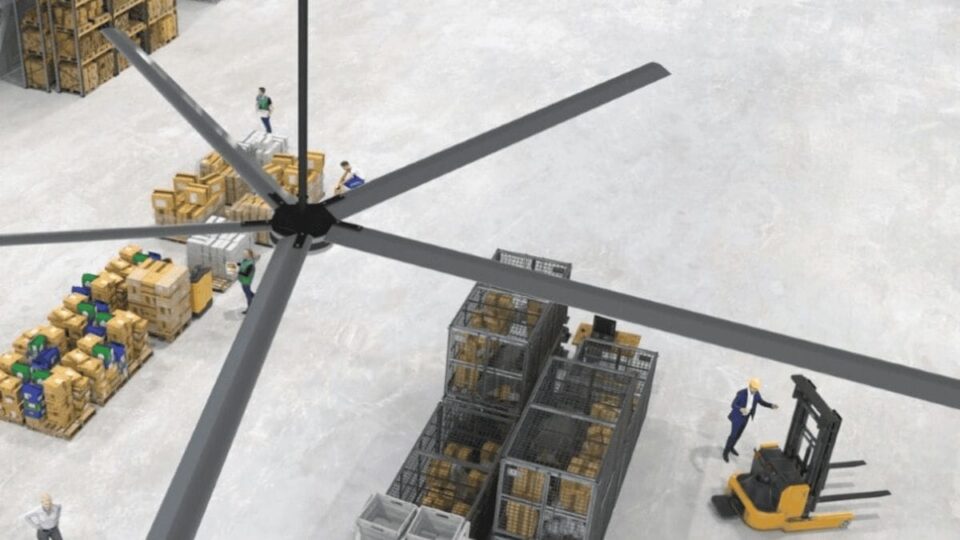High Volume Low Speed (HVLS) fans are often associated with cooling during the summer, but they are also excellent at improving heat efficiency in colder months. By optimising air circulation and reducing energy consumption, they help create a comfortable, energy-efficient working environment. Let’s explore how HVLS fans make a difference during winter.
Where Should HVLS Fans Be Placed?
HVLS fans are most effective when strategically placed. The ideal location depends on the space’s size, shape, and existing heating system layout:
- High Ceilings: Positioning fans near the ceiling allows them to pull down warm air trapped at the top.
- Open Spaces: For warehouses and factories with few internal walls, placing fans centrally ensures consistent airflow throughout the space.
- Near Entrances: Install fans near frequently used doors to mitigate cold drafts that can disrupt the warm environment.

How Do HVLS Fans Improve Heat Efficiency in Colder Months?
High Volume Low Speed (HVLS) fans can significantly enhance heat efficiency during colder months by leveraging a key principle known as destratification.
What Is Destratification?
Destratification refers to the process of mixing the stratified layers of warm and cool air within an enclosed space. In buildings with high ceilings, warm air tends to rise and collect at the top, while cooler air settles near the floor. This creates uneven temperature layers from floor to ceiling, leading to discomfort for workers and wasted energy as heating systems struggle to maintain consistent warmth.
How HVLS Fans Work
HVLS fans, with their large blades and slow rotational speed, facilitate destratification by generating a gentle, conical airflow. This airflow effectively pulls down the warm air trapped at the ceiling, redistributing it throughout the space to create uniform temperatures at every level. Here’s how this process benefits heating efficiency:
- Relieves Strain on Heating Systems: By ensuring warm air circulates evenly across the entire space, HVLS fans reduce the need for heating systems to work excessively to compensate for cold pockets.
- Energy Savings: With temperatures stabilised throughout, thermostats can be set to lower levels without sacrificing comfort, reducing overall energy consumption and lowering energy bills.
- Prevents Heat Loss: By consistently pushing warm air back down to ground level, HVLS fans prevent heat from remaining trapped near the ceiling and going unused, ensuring efficient use of the generated heat.
- Enhances Comfort: Even temperature distribution improves worker comfort and productivity, creating a more hospitable environment that keeps employees warm without requiring drastic increases in heating.
Additional Benefits
In addition to improving heating efficiency, destratification helps prevent condensation and moisture buildup, minimising the risks of mould growth and equipment corrosion. It also aids in reducing odour concentration and improving air quality, creating a healthier working environment.
Read More: For more on the benefits of destratification, check out our blog post, Cost Savings from Destratification Solutions.
How to Use Your HVLS Fan in Winter
- Reverse Mode: Run your HVLS fan in reverse to create an updraft that forces warm air down to ground level. This mode is particularly useful for facilities where air movement is needed without significant direct airflow.
- Lower Speed Settings: Operate the fans at a lower speed to gently mix air layers without generating excessive airflow.
- Adjust Heating Controls: With destratification, you can lower the heating settings because warm air is evenly spread throughout the space.
Fanquip Giant Fans
Fanquip HVLS Giant Fans offer an ultra-low noise solution for industrial and commercial spaces. Here’s how they enhance heating efficiency in winter:
- Ultra-Low Noise Operation: Provides comfort in workshops, production areas, and animal holding sheds without causing distractions.
- 5 Aluminum Blades: Ensure optimal airflow with strong yet lightweight blades.
- Network Control: Network up to 20 fans for centralised control.
- Reverse Mode for Destratification: Evenly distribute warm air throughout the room by reversing the fan direction.
- 7-Speed Settings: Adjust speeds for optimal air movement.

Get Expert Advice for Industrial Ventilation Solutions
Whether it’s reducing your energy bill, improving air circulation, or enhancing the working environment, Fanquip’s Giant Fans provide unparalleled efficiency. Contact us today to learn more about our HVLS fan installation and how they can boost your facility’s heat efficiency in winter while lowering energy costs.
